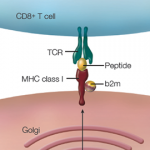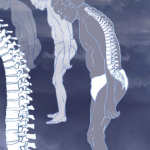
Dr. Reveille
ATLANTA—Research into possible genetic drivers of the axial spondyloarthritis (axSpA), including the role of the genetic marker HLA-B27, is advancing, John D. Reveille, MD, professor and vice chair of medicine at the University of Texas McGovern Medical School, Houston, told attendees at the 2019 ACR/ARP Annual Meeting. Dr. Reveille delivered the Philip Hench, MD, Memorial Lecture, sponsored by the Rheumatology Research Foundation.
This annual lecture honors Dr. Hench, who, along with along with his Mayo Clinic co-worker Edward Calvin Kendall and Swiss chemist Tadeus Reichstein, discovered the hormone cortisone and identified its role in the treatment of rheumatoid arthritis. For this work, the trio received the Nobel Prize for Physiology or Medicine in 1950. Dr. Hench died in 1965.
Dr. Reveille explained that for most people, lower back pain lasts only for a few days to a few weeks and tends to fade away on its own. However, when it lasts for 12 weeks or more, it is considered chronic back pain and can adversely affect quality of life.
Low Back Pain
Most acute low back pain is mechanical in nature, meaning that a disruption occurs in the way the components of the back, including the spine, muscles, intervertebral discs and nerves, fit together and move. Data from the National Health and Nutrition Examination Survey (NHANES) for 2009–10 reveal that about 20% of people affected by acute low back pain develop chronic low back pain with persistent symptoms at one year.1 For the lucky ones, treatment resolves the pain, but for others pain persists despite medical and surgical treatment. A smaller subset may have pain resulting from axial spondyloarthritis (axSpA).
“The magnitude of the burden from low back pain has grown worse in recent years,” said Dr. Reveille. “In the mid-1990s, a study ranking the most burdensome conditions in the U.S. in terms of mortality or poor health as a result of disease put low back pain in sixth place; in 2010, low back pain jumped to third place, with only ischemic heart disease and chronic obstructive pulmonary disease ranking higher.”2-4
Many patients simply live with their condition and don’t seek treatment, Dr. Reveille said. “Although population-based estimates of the prevalence of axSpA and the subset, ankylosing spondylitis (AS), in the United States suggest [the] prevalence [is] as high as 1.4% and 0.57%, respectively, estimates from what is encountered by rheumatologists are much lower, possibly because the overwhelming majority of patients with chronic back pain are never seen by rheumatologists.”5
Diagnosis
But what is axSpA? The Assessment of SpondyloArthritis International Society (ASAS) divides patients with axSpA into two groups: 1) non-radiographic axial spondyloarthritis (nr-axSpA): meets the ASAS classification criteria for axSpA and may have magnetic resonance imaging (MRI) scan results suggestive of sacroiliitis, but without the radiographic (plain X-ray) changes required for a diagnosis of ankylosing spondylitis; and 2) ankylosing spondylitis: meets the criteria for axSpA and also has the pelvic radiographic changes that meet the Modified New York Criteria for AS.
“However,” said Dr. Reveille, “whether patients with AS or nr-axSpA represent a continuum of the same disease process is still under debate.” Part of the difficulty is arriving at an accurate diagnosis of axSpA. As Dr. Reveille pointed out, both AS and nr-axSpA often go undiagnosed for many years. “However, although AS and nr-axSpA have comparable clinical manifestations, AS is more easily identified by the presence of sacroiliitis on radiographs.”
In one 2016 study co-authored by Dr. Reveille, researchers gauged the accuracy of inflammatory back pain in screening for axSpA in rheumatology care settings.6 The researchers studied data from six rheumatology centers for secondary and tertiary rheumatology care, which included consecutive patients with chronic back pain referred to rheumatology clinics with suspicion of axSpA based on positive HLA-B27, inflammatory back pain, or prior imaging with sacroiliitis. Investigators were asked if the patient could be diagnosed with axial spondyloarthritis based on the results. Data were also analyzed separately to determine if patients met ASAS criteria for axSpA and Modified New York Criteria for AS.
Of 461 routinely referred patients, 403 received a final diagnosis. Inflammatory back pain was present in 67.3%, and 44.6% (180/403) were diagnosed with axSpA. “Our findings indicate that among patients with chronic back pain for three or more months beginning at ages younger than 45 years, the presence of one of three SpA features [i.e., HLA-B27 positivity, current inflammatory back pain, and MRI or radiographic evidence of sacroiliitis] is an effective way to identify those with possible axial SpA,” the researchers concluded.
Although diagnosis of the various manifestations of axSpA is improving, its causes remain unknown. Researchers suspect genetics play a dominant role.
Genetic Roots
The major histocompatibility complex (MHC)—also called the human leukocyte antigen (HLA) system—contributes most of the genetic basis of SpA, psoriasis and psoriatic arthritis, said Dr. Reveille. “In fact, there is a widespread sharing of genes in [predisposng patients] to AS, psoriasis, psoriatic arthritis and inflammatory bowel disease.” He added that more than 130 additional non-MHC genes have been implicated in AS predisposition.
“HLA-B27 is the best example of disease association with a hereditary marker,” said Dr. Reveille.
In a 1985 study, researchers reported on two family studies of relatives of HLA-B27-positive AS patients.7 In one cohort of 100 relatives of 30 HLA-B27-positive AS probands, nine relatives did not show radiologic abnormalities of the sacroiliac joints or the spine, but had symptoms of chronic inflammatory back pain previously reported to be characteristic of AS. These nine relatives were all subsequently found to possess HLA-B27, in contrast to only 27 of 60 asymptomatic relatives.
In the other cohort of 101 relatives of 20 randomly chosen HLA-B27-positive AS probands, 13 of 86 relatives without radiographic evidence of sacroiliitis reported “thoracic pain and stiffness,” as defined in the Rome Criteria for AS.7 Twelve of these 13 symptomatic relatives were HLA-B-27 positive. By contrast, among the remaining 73 relatives, only 33 were HLA-B27 positive. The researchers noted that the relatively large number of females found in this group suggests that women are more likely to manifest this variety of disease than men.
More recently, in 2011, Dr. Reveille co-authored the first large‐scale population study of the prevalence of HLA-B27 in the U.S.8 Studying data from the national prevalence of HLA-B27 as determined by the 2009 NHANES, they found the age‐adjusted U.S. prevalence of HLA-B27 was 6.1%; for adults 50–69 years of age, the prevalence of HLA-B27 was 3.6%, suggesting a decrease in HLA-B27 prevalence with age.
Regardless of the cause, Dr. Reveille notes that only 9.1% of axSpA patients are getting care from rheumatologists; 91% are being treated by chiropractors, primary care providers and others who may not know what axSpA and its manifestations are for most patients. “This is unfortunate with the recent medications that have come out that are proving effective for axSpA,” said Dr. Reveille. “Plus, it has been shown that the earlier the intervention, the better you’ll be in treating these diseases.”
Mike Fillon is a healthcare writer living in the Atlanta area.
References
- Shmagel A, Foley R, Ibrahim H. Epidemiology of chronic low back pain in US adults: Data from the 2009–2010 National Health and Nutrition Examination Survey. Arthritis Care Res (Hoboken). 2016 Nov;68(11):1688–1694.
- Hart LG, Deyo RA, Cherkin DC. Physician office visits for low back pain. Frequency, clinical evaluation, and treatment patterns from a U.S. national survey. Spine (Phila Pa 1976). 1995 Jan 1;20(1):11–19.
- Beiske AG, Pedersen ED, Czujko B, et al. Pain and sensory complaints in multiple sclerosis. Eur J Neurol. 2004 Jul;11(7):479–482.
- National Institute of Neurological Disorders and Stroke, National Institutes of Health. Low back pain fact sheet. Updated 2019.
- Reveille JD, Witter JP, Weisman MH. Prevalence of axial spondylarthritis in the United States: Estimates from a cross-sectional survey. Arthritis Care Res. 2012 Jun;64(6):905–910.
- Deodhar A, Mease PJ, Reveille JD, et al. Frequency of axial spondyloarthritis diagnosis among patients seen by US rheumatologists for evaluation of chronic back pain. Arthritis Rheumatol. 2016 Jul;68(7):1669–1676.
- Khan MA, van der Linden SM, Kushner I, et al. Spondylitic disease without radiologic evidence of sacroiliitis in relatives of HLA-B27 positive ankylosing spondylitis patients. Arthritis Rheum. 1985 Jan;28(1):40–43.
- Reveille JD, Hirsch R, Dillon CF, et al. The prevalence of HLA–B27 in the US: Data from the US National Health and Nutrition Examination Survey, 2009. Arthritis Rheum. 2012 May;64(5):1407–1411.


